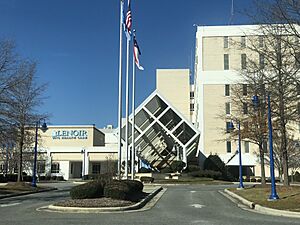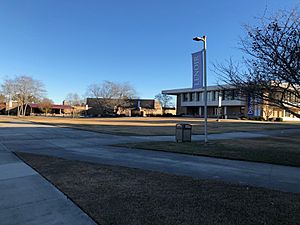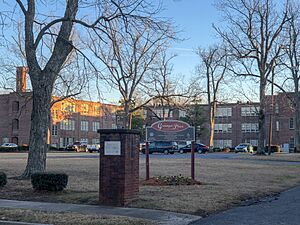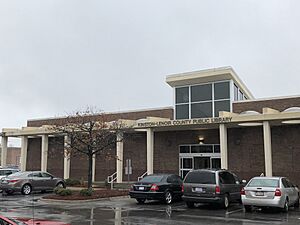Kinston, North Carolina facts for kids
Quick facts for kids
Kinston, North Carolina
|
||
|---|---|---|
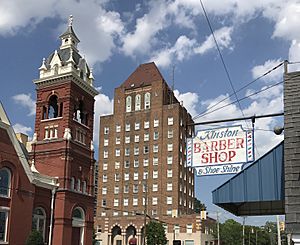
Queen Street United Methodist Church (left) and the Hotel Kinston (center)
|
||
|
||

Location of Kinston within North Carolina
|
||
| Country | United States | |
| State | North Carolina | |
| County | Lenoir | |
| Area | ||
| • Total | 18.43 sq mi (47.73 km2) | |
| • Land | 18.28 sq mi (47.34 km2) | |
| • Water | 0.15 sq mi (0.40 km2) | |
| Elevation | 82 ft (25 m) | |
| Population
(2020)
|
||
| • Total | 19,900 | |
| • Density | 1,088.86/sq mi (420.41/km2) | |
| Time zone | UTC−5 (EST) | |
| • Summer (DST) | UTC−4 (EDT) | |
| ZIP codes |
28501-28504
|
|
| Area code(s) | 252 | |
| FIPS code | 37-35920 | |
| GNIS feature ID | 2404838 | |
Kinston is a city in Lenoir County, North Carolina, United States. About 19,900 people lived there in 2020. It has been the main city, or county seat, of Lenoir County since 1791. Kinston is in the flat coastal plains area of eastern North Carolina.
In 2009, Kinston won the All-America City Award. This was the second time the city earned this special title.
Contents
Kinston's History
Early Days of Kinston
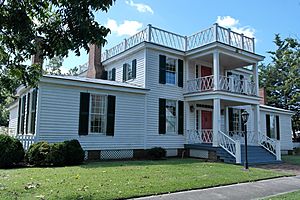
When English settlers first arrived, the Neusiok Native American tribe lived in this area. Before them, many different groups of indigenous peoples had lived here for thousands of years. The English colonists first called the area Atkins Bank. This name came from a high bank on the Neuse River owned by Robert Atkins. There were farms, a place to store tobacco, and a Church of England mission here.
Kinston was officially created in December 1762. It was first named Kingston to honor King George III. The idea for the town came from Richard Caswell, who lived there. He later became the first Governor of North Carolina. After the American Revolution, the people changed the name to Kinston in 1784. This showed they no longer wanted to be connected to royalty. In 1833, it was briefly called Caswell, but the name went back to Kinston the next year.
People chosen to design the town started selling plots of land. To keep their land, buyers had to build brick homes of a certain size within three years. The town was planned with streets named East, North, and South. The Neuse River formed the western edge. The two main roads were named King and Queen Street, and they still have those names today.
In December 1791, Kinston became the county seat for Lenoir County. This happened when Dobbs County was split into Lenoir and Glasgow counties. Kinston was not officially a city until January 1849. After that, the population grew quickly. In 1850, about 455 people lived there. Ten years later, that number more than doubled to over a thousand.
Kinston During the Civil War
During the American Civil War, two training camps were set up near Kinston. These were Camp Campbell and Camp Johnston. A bakery in the city started making large amounts of hardtack, a type of hard biscuit for soldiers. Kinston also had a factory that made shoes for the military. A battle called the Battle of Kinston happened in and around the city on December 14, 1862.
Another battle, the Battle of Wyse Fork, took place near Kinston in March 1865. During this battle, the Confederate ship Neuse was sunk on purpose. This was done to stop Union Army troops from capturing it. Parts of the ship have been found and are now on display. A special museum was built in downtown Kinston to protect the ship's remains. A full-size copy of the ship, called Ram Neuse II, was also built near where the original ship sank. Union forces took over Kinston after the battle.
United States troops stayed in the area during the time after the war, known as the Reconstruction Era.
Kinston After the Civil War
Even after the war, Kinston continued to grow. By 1870, the city had 1,100 people. Ten years later, it had more than 1,700.
In the late 1800s, new industries started in Kinston. One important industry was making horse-drawn carriages. Kinston also became a major center for trading tobacco and cotton. By the early 1900s, over five million pounds of tobacco were sold in Kinston each year. As the city grew, the value of land also increased a lot.
Kinston in the 20th Century
New businesses like lumber and cotton mills were built. Local business owners started processing their own crops. Professional baseball also came to Kinston with a minor league team. Later, a DuPont factory opened to make polyester fibers. Other factories made medicines.
After the 1960s, Kinston's growth slowed down. This was partly because textile production moved to other countries. Efforts to make the economy stronger have had some success.
Kinston was hit hard by floods in 1996 and 1999. Hurricane Fran brought 16 inches (406 mm) of rain to the area in September 1996.
Many buildings and areas in Kinston are listed on the National Register of Historic Places. This means they are important historical sites. Some examples include the American Tobacco Company Prizery, Hotel Kinston, and Harmony Hall. The CSS Neuse and the Kinston Battlefield are also on the list.
Kinston's Geography
Kinston is in the Atlantic coastal plain area of North Carolina. It is mostly on the northeast side of the Neuse River. Kinston is about 26 miles (42 km) east of Goldsboro and 30 miles (48 km) south of Greenville. The Atlantic Ocean is about 57 miles (92 km) to the southeast. Raleigh, the state capital, is 80 miles (129 km) to the northwest.
The city of Kinston covers about 18.6 square miles (48.1 square kilometers). A small part of this area, about 0.2 square miles (0.5 square kilometers), is water.
Kinston's Climate
Kinston has a humid subtropical climate. This means it has hot, humid summers and mild winters. The hottest temperature ever recorded in Kinston was 103°F (39°C) in July 1977 and August 1983. The coldest temperature was -2°F (-19°C) in January 1985.
| Climate data for Kinston, North Carolina, 1991–2020 normals, extremes 1966–present | |||||||||||||
|---|---|---|---|---|---|---|---|---|---|---|---|---|---|
| Month | Jan | Feb | Mar | Apr | May | Jun | Jul | Aug | Sep | Oct | Nov | Dec | Year |
| Record high °F (°C) | 80 (27) |
84 (29) |
89 (32) |
95 (35) |
100 (38) |
101 (38) |
103 (39) |
103 (39) |
102 (39) |
96 (36) |
87 (31) |
83 (28) |
103 (39) |
| Mean maximum °F (°C) | 74.1 (23.4) |
75.9 (24.4) |
82.2 (27.9) |
86.9 (30.5) |
92.3 (33.5) |
96.1 (35.6) |
97.4 (36.3) |
96.0 (35.6) |
92.2 (33.4) |
87.1 (30.6) |
80.7 (27.1) |
74.6 (23.7) |
98.6 (37.0) |
| Mean daily maximum °F (°C) | 56.1 (13.4) |
60.0 (15.6) |
66.7 (19.3) |
75.4 (24.1) |
82.0 (27.8) |
87.9 (31.1) |
90.6 (32.6) |
88.8 (31.6) |
83.8 (28.8) |
76.0 (24.4) |
66.7 (19.3) |
58.9 (14.9) |
74.4 (23.6) |
| Daily mean °F (°C) | 45.7 (7.6) |
48.4 (9.1) |
54.5 (12.5) |
63.4 (17.4) |
70.7 (21.5) |
77.7 (25.4) |
81.0 (27.2) |
79.2 (26.2) |
74.0 (23.3) |
64.6 (18.1) |
55.2 (12.9) |
48.5 (9.2) |
63.6 (17.5) |
| Mean daily minimum °F (°C) | 35.3 (1.8) |
36.8 (2.7) |
42.4 (5.8) |
51.3 (10.7) |
59.5 (15.3) |
67.6 (19.8) |
71.4 (21.9) |
69.6 (20.9) |
64.2 (17.9) |
53.1 (11.7) |
43.8 (6.6) |
38.0 (3.3) |
52.7 (11.5) |
| Mean minimum °F (°C) | 16.7 (−8.5) |
21.2 (−6.0) |
25.0 (−3.9) |
33.9 (1.1) |
44.6 (7.0) |
55.2 (12.9) |
62.3 (16.8) |
60.0 (15.6) |
51.7 (10.9) |
36.4 (2.4) |
27.0 (−2.8) |
22.5 (−5.3) |
14.9 (−9.5) |
| Record low °F (°C) | −2 (−19) |
3 (−16) |
8 (−13) |
24 (−4) |
25 (−4) |
42 (6) |
52 (11) |
47 (8) |
38 (3) |
24 (−4) |
17 (−8) |
6 (−14) |
−2 (−19) |
| Average precipitation inches (mm) | 3.74 (95) |
3.20 (81) |
3.84 (98) |
3.53 (90) |
3.92 (100) |
5.53 (140) |
5.79 (147) |
6.36 (162) |
6.64 (169) |
3.56 (90) |
3.46 (88) |
3.29 (84) |
52.86 (1,344) |
| Average snowfall inches (cm) | 0.3 (0.76) |
0.1 (0.25) |
0.0 (0.0) |
0.0 (0.0) |
0.0 (0.0) |
0.0 (0.0) |
0.0 (0.0) |
0.0 (0.0) |
0.0 (0.0) |
0.0 (0.0) |
0.0 (0.0) |
0.0 (0.0) |
0.4 (1.01) |
| Average precipitation days (≥ 0.01 in) | 8.3 | 7.7 | 8.2 | 7.4 | 8.1 | 9.3 | 11.0 | 10.1 | 8.1 | 6.3 | 7.2 | 8.1 | 99.8 |
| Average snowy days (≥ 0.1 in) | 0.1 | 0.0 | 0.0 | 0.0 | 0.0 | 0.0 | 0.0 | 0.0 | 0.0 | — | — | — | — |
| Source 1: NOAA | |||||||||||||
| Source 2: National Weather Service | |||||||||||||
Kinston's Population and People
| Historical population | |||
|---|---|---|---|
| Census | Pop. | %± | |
| 1850 | 455 | — | |
| 1860 | 1,333 | 193.0% | |
| 1870 | 1,103 | −17.3% | |
| 1880 | 1,216 | 10.2% | |
| 1890 | 1,726 | 41.9% | |
| 1900 | 4,106 | 137.9% | |
| 1910 | 6,995 | 70.4% | |
| 1920 | 9,771 | 39.7% | |
| 1930 | 11,362 | 16.3% | |
| 1940 | 15,388 | 35.4% | |
| 1950 | 18,336 | 19.2% | |
| 1960 | 24,819 | 35.4% | |
| 1970 | 23,020 | −7.2% | |
| 1980 | 25,234 | 9.6% | |
| 1990 | 25,295 | 0.2% | |
| 2000 | 23,688 | −6.4% | |
| 2010 | 21,677 | −8.5% | |
| 2020 | 19,900 | −8.2% | |
| U.S. Decennial Census | |||
Kinston's Population in 2020
| Race | Number | Percentage |
|---|---|---|
| White (non-Hispanic) | 4,854 | 24.39% |
| Black or African American (non-Hispanic) | 13,615 | 68.42% |
| Native American | 33 | 0.17% |
| Asian | 208 | 1.05% |
| Pacific Islander | 10 | 0.05% |
| Other/Mixed | 577 | 2.9% |
| Hispanic or Latino | 603 | 3.03% |
In 2020, there were 19,900 people living in Kinston. There were 8,901 households and 5,050 families.
Kinston's Population in 2010
In 2010, Kinston had 21,677 people. About 67.7% of the people were Black, and 27.8% were White. About 2.4% of the people were Hispanic or Latino.
Getting Around Kinston
Passenger Travel
Kinston does not have passenger train service. The closest train station is in Wilson, about 40 miles (64 km) away.
Air Travel
Kinston has its own airport, the Kinston Regional Jetport (ISO). In 2014-2015, a pilot named Bill Harrelson started and finished a world-record flight around the globe from this airport.
The closest major airport is Raleigh–Durham International Airport. It is about 96 miles (154 km) northwest of Kinston. You can fly to over 45 places from there.
Road Travel
- The main highway in Kinston is US 70. This road goes east and west. It connects Kinston to the North Carolina coast and bigger cities like Raleigh.
- I-795 is the closest interstate highway. It crosses US-70 in Goldsboro.
- Other highways that serve Kinston include US 258, NC 11, NC 58, NC 55, and NC 148.
You can also travel to Kinston by bus using Greyhound service.
Kinston's Religions
Most people in Kinston are Protestant Christians. Many are Baptists and Methodists. There are also many other evangelical groups. Episcopalians and Presbyterians also make up a good part of the population.
The Roman Catholic community in Kinston has grown. Many Hispanic workers have moved to the area. Also, Catholic people from the northeastern United States have moved here to work at the North Carolina Global TransPark and in nearby Greenville, North Carolina.
Kinston used to have a large Jewish community. Like many Jewish communities in the rural South, it has become smaller over time. Temple Israel, Kinston's only synagogue, has about 20 member families and does not have a rabbi.
Education in Kinston
Public Colleges
- Lenoir Community College
Private Colleges
- United American Free Will Baptist Bible College
Public Schools
- Kinston High School
- Lenoir County Early College
- North Lenoir High School
- South Lenoir High School
- Contentnea-Savannah School
- Children's Village Academy
- Rochelle Middle School
- Woodington Middle School
- Banks Elementary School
- Northwest Elementary School
- Moss Hill Elementary School
- Southeast Elementary School
- Southwood Elementary School
- Northeast Elementary School
Private Schools
- Arendell Parrott Academy: This is a private school for kindergarten through 12th grade.
- Bethel Christian Academy: This is a Christian private school for kindergarten through 12th grade.
Kinston's Culture and Fun
Arts and Theater
One important building in Kinston is the Grainger Hill Performing Arts Center. It used to be Grainger High School. It was built in 1924 after a fire destroyed the old Kinston High School. The school was named after Jesse W. Grainger, who donated land and money for its construction. Later, it became Kinston Jr. High School. Now, the building has been changed into Grainger Elderly Housing, which are apartments for older adults.
Tourism and Recreation
The Neuse Regional Library system has its main office in Kinston. It also has branches in Kinston, LaGrange, and Pink Hill.
Kinston is home to the CSS Neuse, a Civil War ship. Its remains are on display at the CSS Neuse Civil War Interpretive Center. You can also find memorials for the Korean and Vietnam War nearby.
The Cultural Heritage Museum opened in 2000. It celebrates the contributions of African Americans in many areas. It honors Black soldiers and officers who fought in the Civil War. It also remembers Black military veterans from all wars, and Negro Baseball League players. The museum aims to create jobs and help the local economy grow.
Kinston has some famous restaurants. The Chef & the Farmer, started by Vivian Howard and Ben Knight, is in downtown Kinston. It has won a special award called the James Beard Award. The TV show A Chef's Life is about this restaurant and its owners. Mother Earth Brewing, which makes craft beer, also started in Kinston in 2008.
Other fun places to visit include the Neuseway Nature Center and Planetarium, the Kinston Center for the Arts, and Grainger Stadium.
Kinston also has annual events. These include the Sand in the Streets concert series, the Annual BBQ Festival on the Neuse River, and the Festival on the Neuse.
Sports in Kinston
Kinston's Grainger Stadium was home to the Down East Wood Ducks, a Class A Minor League Baseball team. They played there from 2017 to 2024. Before that, the Kinston Indians minor league team played there. Many famous baseball players have played in Kinston, including Rick Ferrell, who is in the Baseball Hall of Fame.
The Kinston Drag Strip hosts many motor-sports events. Kinston also has three golf courses: Kinston Country Club, Falling Creek Country Club, and Bill Fay Park Par 3 Golf Course. Barnet Park has a disc golf course. The Galaxy of Sports has a bowling alley, skating rink, and a health club.
In 2012, the Woodmen of the World Community Center and Lions Water Adventure Park opened. This large building has a gym, an Olympic-sized swimming pool, and meeting rooms. It also has an indoor track and sports courts. The city of Kinston now owns it and calls it the Kinston Community Center.
In 1956, a rare perfect game of billiards happened in Kinston. Willie Mosconi sank 150 balls in a row against Jimmy Moore.
In 2018, ESPN called Kinston "America's Basketball Heaven." This is because many players from Kinston High School's varsity team have gone on to play in the NBA.
Parks and Recreation
- Neuseway Nature Park, Campground, and Meeting Facility
- Pearson Park
- Bill Fay Memorial Park
- Emma Webb Park
- Fairfield Park
- Holloway Park
- Lovit Hines Park
- Southeast Park
- Barnet Park
- Lions Adventure Water Park
Notable People from Kinston
- Larry Beck, professional golfer
- Jocelyn Brown, singer
- James Tim Brymn, jazz musician
- Reggie Bullock, NBA player
- Carter Capps, MLB pitcher
- William Caswell, Revolutionary War general
- Dwight Clark, retired NFL receiver
- Quinton Coples, former NFL defensive end
- Steve Cowper, former governor of Alaska
- Richard Cray, singer
- Tony Dawson, retired NBA player
- Ed Grady, actor
- Susannah Sarah Washington Graham, First Lady of North Carolina
- Chris Hatcher, MLB pitcher
- Malcolm Howard, federal judge
- Vivian Howard, chef
- Brandon Ingram, NBA player
- Cedric "Cornbread" Maxwell, retired NBA player
- Mitchell's Christian Singers, gospel group
- Robert "Brother Ah" Northern, jazz musician
- Susan Owens, Washington State Supreme Court justice
- Maceo Parker, musician
- Melvin Parker, drummer
- Marion A. Parrott, lawyer
- Jaime Pressly, actress, model
- Barbara Roy, singer
- Christa Sauls, actress, model
- Charles Shackleford, retired NBA player
- J. Carlyle Sitterson, educator
- Tab Smith, swing saxophonist
- Frank Snepp, journalist
- Jerry Stackhouse, retired NBA player
- George Suggs, MLB pitcher
- Ola B. Watford, geophysicist
- Mitchell Wiggins, retired NBA player
- Tyrone Willingham, college football coach
See Also
 In Spanish: Kinston (Carolina del Norte) para niños
In Spanish: Kinston (Carolina del Norte) para niños



